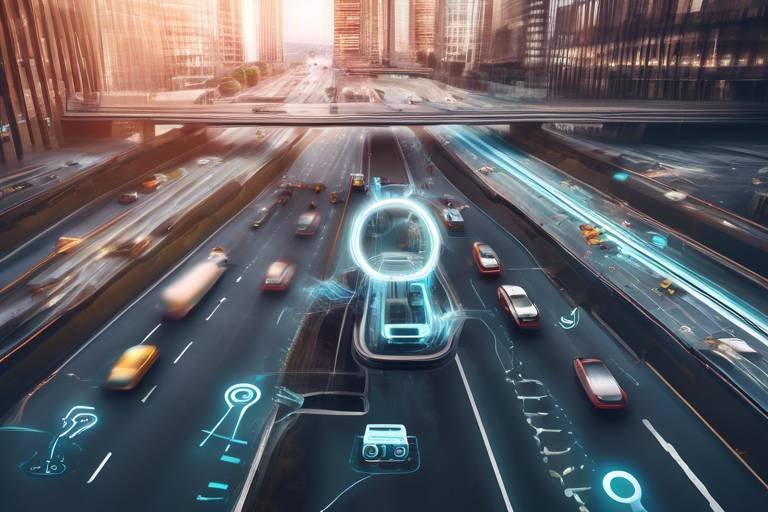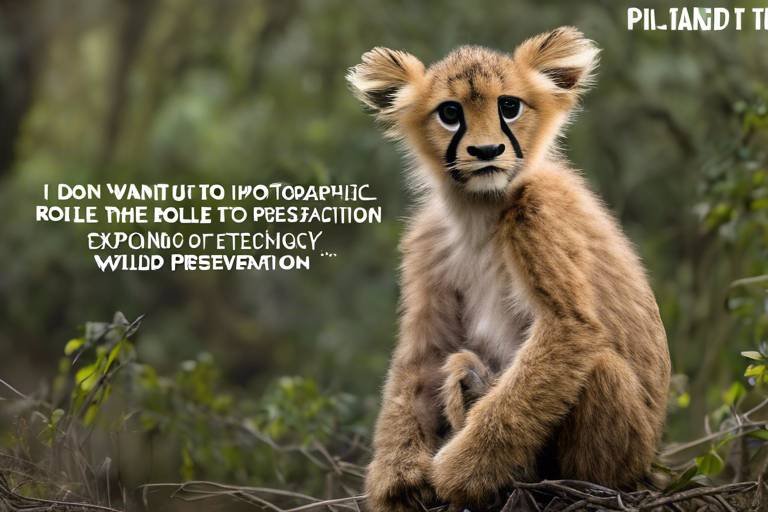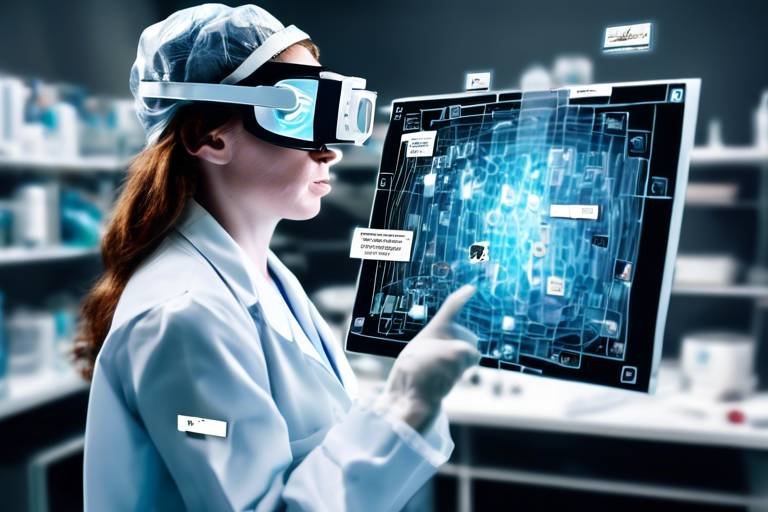The Future of Biotechnological Innovations
Welcome to the fascinating world of biotechnology, where the boundaries of science and innovation are constantly being pushed. As we stand on the brink of a new era, it’s impossible not to feel a sense of excitement about what the future holds. Imagine a world where diseases that once seemed insurmountable are tackled head-on, where food security is no longer a distant dream, and where our understanding of life itself is transformed. This article explores the advancements in biotechnology, highlighting emerging trends, applications, and ethical considerations that will shape the future landscape of this dynamic field.
Innovations like CRISPR, synthetic biology, and gene editing are revolutionizing biotechnology, enabling precise modifications and applications in medicine, agriculture, and environmental sustainability. These technologies are not just buzzwords; they represent a seismic shift in how we approach biological challenges. For instance, CRISPR technology allows scientists to edit genes with unprecedented accuracy, akin to using a word processor to correct typos in a document. This level of precision opens the door to groundbreaking applications that can change the fabric of our society.
Biotechnology is transforming healthcare through personalized medicine, regenerative therapies, and advanced drug development. Imagine a world where treatments are tailored specifically to your genetic makeup, enhancing efficacy and minimizing side effects. This is not science fiction; it's the reality that biotechnology is ushering in. With the ability to analyze individual genetic profiles, healthcare providers can offer solutions for previously untreatable conditions, significantly enhancing patient outcomes.
Tailoring treatments to individual genetic profiles allows for more effective therapies, minimizing side effects, and improving overall health management for patients with complex diseases. The concept of personalized medicine is akin to having a custom-made suit that fits perfectly; it’s designed specifically for you. This approach not only improves the quality of care but also empowers patients to take an active role in their health journey.
Advancements in genomic sequencing technologies are providing insights into genetic predispositions, paving the way for targeted interventions and proactive health measures. As we delve deeper into our DNA, we uncover secrets that can help us prevent diseases before they even manifest. This proactive approach is like having a crystal ball that allows us to foresee potential health issues and address them head-on.
Cell therapy, including stem cell research, holds promise for repairing damaged tissues and organs, potentially revolutionizing treatment for various chronic conditions. Think of it as a repair shop for the body, where damaged parts can be replaced or rejuvenated. This innovative approach could change the lives of millions, offering hope where there was once despair.
Regenerative medicine focuses on repairing or replacing damaged tissues and organs, utilizing techniques such as tissue engineering and stem cell therapy to restore normal function. The idea of regenerating lost or damaged body parts is not just a dream; it's becoming a reality. Imagine a future where spinal cord injuries can be healed, or organs can be grown in labs, ready for transplantation.
Innovations in agricultural biotechnology are enhancing crop yields, improving resistance to pests and diseases, and promoting sustainable farming practices to meet global food demands. As the global population continues to rise, the pressure on our food systems intensifies. Biotechnology offers solutions that can help us meet these challenges head-on, ensuring that we can feed the world sustainably.
GMOs are engineered to exhibit desirable traits, such as increased nutritional value and resilience to environmental stressors, contributing to food security and agricultural sustainability. Consider GMOs as the superheroes of the agricultural world, designed to withstand the harshest conditions while providing essential nutrients. This innovation not only helps farmers but also ensures that consumers have access to healthier food options.
Biotechnology is driving sustainable agricultural practices, including biofertilizers and biopesticides, reducing reliance on chemical inputs and promoting eco-friendly farming. By harnessing nature's own processes, we can cultivate crops that are not only productive but also environmentally friendly. This shift towards sustainability is like turning a new leaf; it represents a commitment to preserving our planet for future generations.
As biotechnology advances, ethical dilemmas arise, necessitating discussions around genetic privacy, biosecurity, and the implications of manipulating life at a fundamental level. These discussions are crucial as we navigate the complexities of biotechnological innovations. It’s essential to consider the moral implications of our actions, ensuring that progress does not come at the expense of our values.
The collection and use of genetic data raise concerns about privacy and consent, emphasizing the need for robust regulations to protect individual rights. Just as we safeguard our personal information online, we must also protect our genetic data from misuse. Establishing clear guidelines will help ensure that advancements in biotechnology respect individual privacy.
Emerging biotechnologies pose potential biosecurity threats, requiring vigilance and comprehensive policies to mitigate risks associated with genetic manipulation and pathogen research. As we explore the frontiers of biotechnology, we must remain cautious and proactive, ensuring that our innovations do not inadvertently create new problems.
The future of biotechnology is poised for growth, with trends such as artificial intelligence integration, biomanufacturing, and advancements in diagnostics shaping the next wave of innovations. Just as technology has transformed our daily lives, biotechnology is set to redefine our approach to health, agriculture, and environmental sustainability.
- What is biotechnology? Biotechnology is the use of living organisms or biological systems to develop products and technologies that improve human life and the environment.
- How does CRISPR work? CRISPR is a gene-editing technology that allows scientists to alter DNA sequences and modify gene function, enabling precise genetic changes.
- What are the ethical concerns surrounding biotechnology? Key concerns include genetic privacy, biosecurity risks, and the moral implications of manipulating life forms.
- How is biotechnology impacting agriculture? Biotechnology enhances crop yields, improves resistance to pests, and promotes sustainable farming practices, helping to meet global food demands.

Emerging Technologies in Biotechnology
In the ever-evolving field of biotechnology, emerging technologies are paving the way for groundbreaking advancements that promise to transform our world. Innovations such as CRISPR, synthetic biology, and gene editing are not just buzzwords; they are the driving forces behind a revolution that is reshaping various sectors, including medicine, agriculture, and environmental sustainability. Imagine a world where we can edit the genetic code of organisms with the precision of a word processor—this is the power that these technologies hold.
At the forefront of this revolution is CRISPR (Clustered Regularly Interspaced Short Palindromic Repeats), a tool that allows scientists to make precise changes to DNA. This technology has opened up new possibilities for treating genetic disorders and developing crops that can withstand harsh climates. For instance, consider the potential of using CRISPR to eliminate genetic diseases before they manifest. It’s like having a time machine that allows us to fix problems before they even arise!
Synthetic biology is another exciting area within biotechnology that combines biology and engineering to create new biological parts, devices, and systems. This field has applications ranging from creating biofuels to developing new medicines. By designing organisms that can perform specific tasks, we can tackle some of the biggest challenges facing humanity today, such as climate change and food security. The idea of programming living organisms to produce what we need is akin to writing software for a computer, but in this case, the 'hardware' is alive.
Gene editing technologies, particularly those that utilize the CRISPR system, are also revolutionizing research and development in biotechnology. These tools allow scientists to edit genes within living organisms, leading to significant advancements in medical research and agricultural enhancements. With gene editing, we can not only understand diseases better but also develop treatments that are tailored to individual patients. This personalized approach is a game-changer in healthcare.
As we delve deeper into these technologies, it’s crucial to consider their implications. The potential for genetic modification raises questions about ethics, safety, and the long-term effects on ecosystems and human health. For example, while genetically modified organisms (GMOs) can enhance food production, they also raise concerns about biodiversity and environmental impact. It’s a delicate balance between innovation and responsibility.
In conclusion, the landscape of biotechnology is rapidly changing, driven by these emerging technologies. As we harness the power of CRISPR, synthetic biology, and gene editing, we must also engage in thoughtful discussions about the ethical implications of these advancements. The future of biotechnology holds immense potential, and it is our responsibility to navigate this uncharted territory wisely.
- What is CRISPR and how does it work? CRISPR is a revolutionary gene-editing technology that allows scientists to make precise alterations to DNA, enabling advancements in various fields such as medicine and agriculture.
- What are the ethical concerns surrounding biotechnology? Ethical concerns include genetic privacy, the potential for misuse of genetic data, and the long-term impacts of genetic modifications on ecosystems and human health.
- How is biotechnology impacting agriculture? Biotechnology is enhancing agricultural practices through the development of genetically modified organisms (GMOs) that are more resilient to pests and environmental stressors, ultimately contributing to food security.

Applications in Medicine
Biotechnology is not just a buzzword; it’s a transformative force that is reshaping the landscape of healthcare. With the advent of innovative techniques and technologies, we are witnessing a revolution in how we approach medical treatments. Imagine a world where diseases that once seemed insurmountable can now be tackled with precision and care. This is the promise of biotechnology in medicine, paving the way for personalized therapies, advanced drug development, and regenerative treatments that were once the stuff of science fiction.
One of the most exciting developments in this field is personalized medicine. This approach tailors medical treatment to the individual characteristics of each patient. By analyzing a patient's genetic makeup, healthcare providers can design treatments that are more effective and have fewer side effects. It’s like having a custom-made suit that fits perfectly rather than wearing something off the rack that might not suit your style or comfort. With personalized medicine, patients can receive therapies that are specifically designed for their unique genetic profiles, particularly for complex diseases like cancer.
Thanks to advancements in genomic sequencing, we now have the ability to decode the genetic information of individuals with remarkable speed and accuracy. This technology not only reveals genetic predispositions to certain diseases but also opens the door for targeted interventions. For example, if a patient is found to carry a genetic marker for a specific type of cancer, doctors can implement proactive health measures tailored to mitigate that risk. It's akin to having a roadmap that guides you through a potentially hazardous terrain, allowing you to navigate your health journey with confidence.
Another groundbreaking area is cell therapy, which includes the revolutionary field of stem cell research. This approach holds immense potential for repairing damaged tissues and organs. Imagine being able to regenerate heart tissue after a heart attack or restore vision in patients suffering from degenerative eye diseases. The possibilities are endless, and researchers are continuously exploring how to harness the power of stem cells to tackle chronic conditions that have long plagued humanity.
Moreover, regenerative medicine is taking things a step further by focusing on the repair or replacement of damaged tissues and organs. Techniques such as tissue engineering and stem cell therapy are at the forefront of this exciting area. Picture a scenario where damaged organs can be replaced with lab-grown alternatives, significantly enhancing the quality of life for patients. This not only offers hope for those with chronic ailments but also reduces the need for organ transplants, which are often in short supply.
As we delve deeper into the applications of biotechnology in medicine, it becomes clear that the future is bright. With continuous research and development, we are on the brink of breakthroughs that could redefine how we understand and treat diseases. The integration of biotechnology into healthcare promises not just to enhance patient outcomes but also to improve the overall efficiency of healthcare systems worldwide.
- What is personalized medicine? Personalized medicine tailors medical treatments to the individual characteristics of each patient, often based on genetic information.
- How does genomic sequencing help in healthcare? Genomic sequencing provides insights into an individual's genetic predispositions, allowing for targeted interventions and proactive health measures.
- What is cell therapy? Cell therapy involves using living cells to treat or prevent disease, with stem cell research being a significant aspect of this field.
- What is regenerative medicine? Regenerative medicine focuses on repairing or replacing damaged tissues and organs using techniques such as tissue engineering and stem cell therapy.

Personalized Medicine
Imagine walking into a doctor’s office and receiving a treatment plan that is tailored just for you, based on your unique genetic makeup. is not just a dream; it’s a groundbreaking reality that is transforming the healthcare landscape. By analyzing an individual's genetic information, healthcare providers can now offer targeted therapies that are significantly more effective than traditional one-size-fits-all approaches. This shift is akin to wearing a custom-made suit instead of a generic outfit off the rack—it's designed to fit you perfectly.
The essence of personalized medicine lies in its ability to minimize side effects and enhance treatment efficacy. For instance, patients suffering from complex diseases such as cancer can benefit from treatments that specifically target the genetic mutations driving their illness. This precision means that instead of enduring the harsh side effects of broad-spectrum chemotherapy, patients can opt for drugs that are designed to attack cancer cells while sparing healthy tissue. It’s like using a laser instead of a sledgehammer—more precise, less collateral damage.
One of the key components of personalized medicine is genomic sequencing. This technology allows healthcare professionals to delve deep into your DNA, uncovering insights that were previously hidden. With genomic sequencing, doctors can identify genetic predispositions to various diseases, enabling proactive health measures. Imagine knowing that you have a higher risk for a particular condition; you could take preventative steps long before symptoms even appear. It’s like having a roadmap for your health, guiding you to make informed decisions.
Another exciting aspect is cell therapy, particularly in the realm of stem cell research. This innovative approach holds immense potential for repairing damaged tissues and organs. Think of it as a biological repair shop where your body’s own cells are used to fix what’s broken. For individuals with chronic conditions, this could mean a dramatic improvement in quality of life, as therapies evolve to harness the body’s natural healing abilities.
However, as we embrace these advancements, it’s crucial to remember that personalized medicine also brings forth ethical considerations. Issues such as genetic privacy and the implications of genetic data usage must be carefully navigated. Just because we can do something doesn’t always mean we should. The conversation around these topics is vital as we move forward into a future where medicine is not just personalized, but also responsible.
- What is personalized medicine? Personalized medicine refers to tailoring medical treatment to the individual characteristics of each patient, particularly their genetic profile.
- How does genomic sequencing work? Genomic sequencing involves analyzing an individual's DNA to identify genetic variations that may affect their health and treatment options.
- What are the benefits of cell therapy? Cell therapy can help repair damaged tissues and organs, potentially leading to better outcomes for chronic diseases.
- What ethical concerns are associated with personalized medicine? Ethical concerns include genetic privacy, consent for genetic data usage, and the potential for discrimination based on genetic information.

Genomic Sequencing
Genomic sequencing is a groundbreaking advancement that has fundamentally changed our understanding of genetics and health. Imagine being able to read the entire instruction manual of a human being, where every gene is a paragraph detailing how our bodies function, develop, and respond to diseases. This technology allows scientists and healthcare professionals to decode the complex blueprint of our DNA, offering insights that were previously unimaginable. With the advent of next-generation sequencing (NGS), the process has become faster, cheaper, and more accessible, paving the way for widespread applications in personalized medicine and beyond.
The implications of genomic sequencing are profound. By analyzing an individual's genome, we can identify genetic predispositions to various diseases, enabling healthcare providers to tailor interventions specifically to each patient's needs. This is particularly significant for conditions such as cancer, where knowing the genetic makeup of a tumor can inform treatment decisions and lead to better outcomes. For instance, patients with specific genetic mutations might respond better to particular therapies, while others may experience adverse effects from standard treatments.
Moreover, genomic sequencing is not limited to individual health; it has broader applications in public health and epidemiology. By sequencing the genomes of pathogens, scientists can track outbreaks and understand how diseases spread within populations. This capability is crucial for developing effective vaccines and treatments, especially in the face of emerging infectious diseases. For example, during the COVID-19 pandemic, genomic sequencing played a vital role in monitoring the virus's mutations, guiding public health responses, and informing vaccine development.
As we delve deeper into the world of genomic sequencing, it’s essential to acknowledge the ethical considerations that come with it. The ability to access and interpret genetic information raises significant questions about privacy, consent, and the potential for discrimination based on genetic data. It is crucial for policymakers to create robust frameworks that protect individuals' rights while promoting the responsible use of genomic data in research and healthcare.
In summary, genomic sequencing stands at the forefront of biotechnological innovation, offering transformative potential for personalized medicine, public health, and our understanding of human biology. As this field continues to evolve, it promises to unlock new frontiers in healthcare, but it also calls for careful consideration of the ethical implications that accompany such powerful technologies.
- What is genomic sequencing?
Genomic sequencing is the process of determining the complete DNA sequence of an organism's genome, which includes all of its genes and non-coding sequences. - How does genomic sequencing benefit personalized medicine?
By understanding an individual's genetic makeup, healthcare providers can tailor treatments to improve efficacy and reduce side effects. - Are there privacy concerns associated with genomic sequencing?
Yes, the collection and use of genetic data raise significant privacy issues, necessitating strong regulations to protect individual rights. - How is genomic sequencing used in public health?
It helps track disease outbreaks, understand pathogen mutations, and informs vaccine development strategies.

Cell Therapy
Cell therapy is an exciting frontier in the realm of biotechnology, offering a beacon of hope for patients suffering from a variety of chronic conditions. Imagine being able to repair damaged tissues or even regenerate entire organs with your own cells! This innovative approach leverages the body’s natural healing processes, primarily through the use of stem cells, which have the remarkable ability to develop into different cell types. Whether it’s repairing heart tissue after a heart attack or regenerating nerve cells in spinal cord injuries, the potential applications of cell therapy are vast and transformative.
One of the most compelling aspects of cell therapy is its potential to address diseases that currently have limited treatment options. For instance, conditions like Parkinson's disease, diabetes, and certain types of cancer may one day be treated with therapies that harness the power of cells. By injecting healthy cells into damaged areas, we can essentially 'reset' the body's healing mechanisms. This not only improves patient outcomes but also enhances the quality of life for individuals who have long struggled with debilitating ailments.
However, while the promise of cell therapy is immense, it is crucial to navigate the challenges that come with it. Regulatory hurdles, ethical considerations, and the complexities of cell sourcing and manipulation must be addressed to ensure safe and effective treatments. For example, there are ongoing discussions about the sourcing of stem cells, particularly embryonic stem cells, which raises ethical questions about consent and the implications of using cells derived from human embryos.
Furthermore, the technology behind cell therapy is advancing rapidly, with researchers exploring various methods to enhance the efficacy and safety of these treatments. Techniques such as gene editing, particularly CRISPR, are being integrated into cell therapy protocols to improve outcomes. By altering the genetic makeup of stem cells before they are administered to patients, scientists aim to create cells that are not only more effective but also resistant to potential complications.
In summary, cell therapy stands at the forefront of biotechnological innovation, promising to revolutionize how we approach treatment for chronic diseases. As research progresses and regulatory frameworks evolve, we are likely to witness a surge in clinical applications that could change the landscape of medicine forever. The journey is just beginning, and the possibilities are as exciting as they are profound.
- What is cell therapy? Cell therapy involves the use of living cells to treat diseases and injuries, often utilizing stem cells to regenerate damaged tissues.
- What conditions can be treated with cell therapy? Cell therapy has the potential to treat a variety of conditions, including heart disease, diabetes, Parkinson's disease, and spinal cord injuries.
- Are there risks associated with cell therapy? Yes, like any medical treatment, cell therapy carries risks, including immune rejection, infection, and complications from the procedure itself.
- How is cell therapy different from traditional treatments? Unlike traditional treatments that often focus on symptom management, cell therapy aims to repair or regenerate damaged tissues, potentially addressing the root cause of the disease.

Regenerative Medicine
Regenerative medicine is a groundbreaking field that focuses on the repair and replacement of damaged tissues and organs. Imagine a world where debilitating injuries or chronic diseases could be treated not just by managing symptoms, but by actually restoring the body’s natural functions. This is the promise of regenerative medicine, utilizing innovative techniques such as tissue engineering and stem cell therapy. These methods aim to harness the body’s own healing mechanisms, offering hope for conditions that were previously deemed untreatable.
At the heart of regenerative medicine lies the remarkable potential of stem cells. These unique cells have the ability to develop into various cell types, making them invaluable for repairing damaged tissues. For instance, researchers are exploring how stem cells can regenerate heart tissue after a heart attack, potentially restoring normal function and improving patient outcomes. The journey of stem cell research is akin to a thrilling adventure, where every discovery opens up new possibilities for healing and recovery.
Moreover, tissue engineering combines principles from engineering and biology to create artificial organs and tissues. This process often involves using scaffolding materials that provide structural support for cells to grow and develop. Imagine constructing a miniature organ in a lab, which could eventually be implanted into a patient, effectively replacing a failing organ. This approach not only addresses the shortage of organ donors but also reduces the risks associated with transplant rejection.
However, as with any rapidly advancing field, regenerative medicine comes with its challenges. Ethical considerations regarding the use of stem cells, particularly those derived from embryos, have sparked intense debates. It’s crucial to navigate these discussions thoughtfully, balancing the potential benefits of these technologies with the ethical implications they entail.
In summary, regenerative medicine represents a beacon of hope for many patients suffering from chronic conditions or injuries. With advancements in stem cell research and tissue engineering, the future looks bright. As we continue to explore these innovative avenues, we may soon witness the reality of restoring health and function in ways we once only dreamed of.
- What is regenerative medicine?
Regenerative medicine is a field of medicine focused on repairing or replacing damaged tissues and organs using techniques like stem cell therapy and tissue engineering. - How do stem cells work in regenerative medicine?
Stem cells can develop into various cell types and are used to regenerate damaged tissues, offering potential treatments for a range of conditions. - Are there ethical concerns associated with regenerative medicine?
Yes, particularly regarding the use of embryonic stem cells, which raises questions about consent and the moral implications of manipulating human life. - What are some potential applications of regenerative medicine?
Applications include repairing heart tissue after a heart attack, regenerating damaged cartilage, and developing artificial organs for transplantation.

Biotechnology in Agriculture
Biotechnology is making significant strides in agriculture, reshaping how we approach food production and sustainability. In a world where the population is projected to reach nearly 10 billion by 2050, the demand for food is escalating rapidly. Traditional farming methods alone may not suffice to meet this challenge. This is where biotechnology steps in, offering innovative solutions to enhance crop yields, improve resistance to pests and diseases, and promote sustainable farming practices.
One of the most notable advancements in agricultural biotechnology is the development of Genetically Modified Organisms (GMOs). These organisms are engineered to exhibit desirable traits, which can include:
- Increased nutritional value
- Enhanced resistance to pests and diseases
- Improved resilience to environmental stressors, such as drought or flooding
By incorporating these traits, GMOs contribute significantly to food security and agricultural sustainability. For instance, crops like Bt corn and Roundup Ready soybeans have been engineered to withstand specific challenges, leading to higher productivity and reduced reliance on chemical pesticides.
Moreover, biotechnology is not just about modifying crops; it's also about promoting sustainable practices. Innovations such as biofertilizers and biopesticides are revolutionizing farming by reducing the need for synthetic chemicals. These bio-based inputs not only enhance soil health but also minimize the environmental impact of agriculture. By utilizing natural processes and organisms, farmers can achieve better yields while maintaining ecological balance.
Another exciting area of agricultural biotechnology is the development of precision agriculture. This approach leverages data analytics and technology to optimize farming practices. By utilizing GPS and remote sensing technologies, farmers can monitor crop health in real-time, allowing for targeted interventions. This means that resources such as water, fertilizers, and pesticides can be applied more efficiently, reducing waste and increasing productivity.
As we look to the future, the integration of biotechnology in agriculture appears to be a crucial component in addressing global food challenges. With ongoing research and development, we can expect to see even more innovative solutions that will not only boost agricultural output but also promote environmental sustainability. This dual focus is essential as we strive to create a more resilient food system capable of withstanding the pressures of climate change and a growing population.
- What are GMOs?
GMOs, or Genetically Modified Organisms, are organisms whose genetic material has been altered using genetic engineering techniques to exhibit desired traits. - How does biotechnology improve crop yields?
Biotechnology enhances crop yields by developing plants that are resistant to pests, diseases, and harsh environmental conditions, allowing for more robust growth and higher productivity. - Are GMOs safe to eat?
Numerous studies and regulatory bodies, including the FDA and WHO, have deemed GMOs safe for human consumption, emphasizing the importance of rigorous testing. - What are biofertilizers?
Biofertilizers are natural fertilizers that contain living microorganisms, which promote plant growth by increasing the availability of nutrients in the soil. - How can precision agriculture benefit farmers?
Precision agriculture allows farmers to make data-driven decisions, optimizing resource use and improving crop management practices, ultimately leading to increased efficiency and profitability.

Genetically Modified Organisms (GMOs)
Genetically Modified Organisms, or GMOs, are organisms whose genetic material has been altered using genetic engineering techniques. This revolutionary approach allows scientists to introduce desirable traits into plants, animals, and microorganisms, fundamentally changing the landscape of agriculture and food production. Imagine being able to create crops that can withstand harsh weather conditions, resist pests, and even enhance nutritional value—all through the magic of modern science! This potential is not just a dream; it's happening right now.
One of the primary goals of developing GMOs is to improve food security. As the global population continues to rise, the demand for food is skyrocketing. Traditional farming methods alone may not be enough to meet this demand, leading to the exploration of GMOs as a viable solution. For instance, crops like Bt cotton and Bt corn have been engineered to produce their own insecticides, drastically reducing the need for chemical pesticides. This not only benefits farmers by lowering costs but also contributes to a healthier ecosystem.
However, the conversation around GMOs isn't without controversy. Critics often raise concerns about the long-term effects of consuming genetically modified foods and the potential for unforeseen ecological consequences. To address these concerns, rigorous testing and regulation are essential. For example, in the United States, the USDA, FDA, and EPA work together to ensure that GMOs are safe for both human consumption and the environment. These agencies evaluate the safety of GMOs through extensive research and trials before they can be approved for widespread use.
In addition to enhancing crop resilience, GMOs can also play a significant role in promoting sustainability. By reducing the need for chemical fertilizers and pesticides, genetically modified crops can lead to more sustainable farming practices. Furthermore, GMOs can be designed to require less water or to thrive in poor soil conditions, making them a crucial tool in combating the challenges posed by climate change.
To illustrate the benefits and concerns surrounding GMOs, consider the following table that summarizes key points:
| Aspect | Benefits | Concerns |
|---|---|---|
| Food Security | Higher yields and resistance to pests. | Potential long-term health effects. |
| Sustainability | Reduced need for chemical inputs. | Impact on biodiversity. |
| Economic | Lower production costs for farmers. | Market dominance by a few large companies. |
In conclusion, GMOs represent a fascinating intersection of technology and agriculture, offering solutions to some of the most pressing challenges we face today. As we continue to explore the potential of genetically modified organisms, it's essential to engage in informed discussions that consider both the benefits and the risks. After all, the future of food security and sustainability may very well depend on our ability to navigate these complex issues.
- What are GMOs? GMOs are organisms that have had their DNA altered through genetic engineering to exhibit desirable traits.
- Are GMOs safe to eat? Yes, GMOs undergo rigorous testing by various regulatory bodies to ensure their safety for human consumption.
- How do GMOs help with food security? GMOs can increase crop yields and improve resistance to pests and diseases, helping to meet the growing food demands of the global population.
- What are the environmental impacts of GMOs? While GMOs can reduce the need for chemical pesticides and fertilizers, concerns about their effects on biodiversity and ecosystems remain.

Sustainable Practices
In the quest for a greener planet, in biotechnology are becoming increasingly important. As we face the challenges of climate change, dwindling resources, and a growing population, it's crucial to adopt methods that not only enhance agricultural productivity but also protect our environment. This is where biotechnology steps in, offering innovative solutions that are both effective and eco-friendly.
One of the most significant advancements in sustainable agriculture is the development of biofertilizers. Unlike traditional fertilizers that can deplete soil health, biofertilizers enhance soil fertility by promoting the growth of beneficial microorganisms. These microorganisms help in nutrient absorption, making crops more resilient to environmental stresses. For instance, rhizobacteria can improve plant growth by fixing nitrogen from the atmosphere, reducing the need for synthetic fertilizers. This not only minimizes chemical runoff into waterways but also fosters a healthier ecosystem.
Similarly, biopesticides are revolutionizing pest management. By utilizing natural organisms or substances to control pests, biopesticides offer a safer alternative to chemical pesticides. They are less harmful to non-target species, including beneficial insects and humans. For example, the bacterium Bacillus thuringiensis produces proteins that are toxic to specific insects but harmless to other wildlife. This targeted approach reduces the overall chemical load in agricultural practices, promoting biodiversity and sustainability.
Moreover, biotechnology is paving the way for crop resilience. Through genetic engineering, scientists are creating crops that can withstand extreme weather conditions, such as droughts or floods. These genetically modified organisms (GMOs) are designed to thrive in challenging environments, ensuring food security even when nature throws a curveball. For instance, drought-resistant corn varieties have been developed to maintain yields despite reduced water availability, providing farmers with a reliable option amidst climate unpredictability.
Additionally, sustainable practices in biotechnology extend beyond just agriculture. They encompass the entire supply chain, from production to consumption. For example, bioplastics derived from renewable resources are emerging as a sustainable alternative to conventional plastics. These bioplastics can reduce plastic pollution and are often biodegradable, contributing to a circular economy. As consumers become more environmentally conscious, the demand for such sustainable products is likely to grow, pushing industries to innovate further.
In conclusion, the integration of sustainable practices within biotechnology is not just a trend; it's a necessity for the future of our planet. By embracing biofertilizers, biopesticides, and resilient crops, we can move towards a more sustainable agricultural model that meets the needs of a growing population while safeguarding our environment. As we continue to explore the potential of biotechnology, it’s essential to keep sustainability at the forefront of our innovations.
- What are biofertilizers? Biofertilizers are natural fertilizers that enhance soil fertility by promoting the growth of beneficial microorganisms.
- How do biopesticides work? Biopesticides utilize natural organisms or substances to control pests, reducing the need for chemical pesticides.
- What is the role of GMOs in sustainable agriculture? GMOs are engineered to withstand environmental stresses, ensuring food security in challenging conditions.
- Are bioplastics environmentally friendly? Yes, bioplastics are derived from renewable resources and are often biodegradable, helping to reduce plastic pollution.

Ethical Considerations
As we venture deeper into the realm of biotechnology, we must grapple with a myriad of ethical dilemmas that arise from these groundbreaking advancements. The power to manipulate life at its most fundamental level raises significant questions about our responsibilities as stewards of this technology. One of the most pressing issues is genetic privacy. With the ability to sequence genomes and analyze genetic data, the potential for misuse becomes a serious concern. Imagine a world where your genetic information could be accessed without your consent, leading to discrimination in healthcare or employment. This is not just a distant possibility; it’s a reality we must prepare for.
Furthermore, the collection and use of genetic data necessitate robust regulations to safeguard individual rights. It’s crucial that we establish clear guidelines that respect personal privacy while still allowing for the advancement of scientific research. Without these protections, we risk creating a society where genetic information could be used against individuals in ways we cannot yet fully comprehend.
Another significant ethical consideration is biosecurity risks. As biotechnological innovations proliferate, the potential for misuse of these technologies increases. For instance, the manipulation of pathogens for research purposes could inadvertently lead to the creation of dangerous biological agents. This necessitates comprehensive policies and vigilance to mitigate risks associated with genetic manipulation. We must ask ourselves: how can we balance the pursuit of knowledge with the need for safety? The answer lies in establishing stringent oversight and ethical frameworks that guide research practices.
Moreover, the implications of manipulating life extend beyond individual rights and safety. They touch on broader societal values and the essence of what it means to be human. As we explore the possibilities of gene editing and synthetic biology, we must consider the potential consequences of creating organisms that do not exist in nature. Will we face unforeseen ecological impacts? How will these changes affect biodiversity? The answers to these questions require careful deliberation and a commitment to ethical standards that prioritize the well-being of both humanity and the planet.
In conclusion, as we stand on the brink of a biotechnological revolution, we must engage in thoughtful discussions around the ethical implications of our innovations. By addressing concerns related to genetic privacy, biosecurity, and the moral responsibilities of manipulating life, we can navigate this complex landscape with integrity and foresight. The future of biotechnology holds immense promise, but it is our ethical considerations that will ultimately shape its trajectory.
- What are the main ethical concerns in biotechnology?
The primary ethical concerns include genetic privacy, biosecurity risks, and the implications of manipulating life forms.
- How can we protect genetic privacy?
Implementing robust regulations and guidelines for the collection and use of genetic data is crucial to safeguarding individual rights.
- What are biosecurity risks associated with biotechnology?
Biosecurity risks include the potential misuse of biotechnological innovations, such as the creation of dangerous pathogens.
- Why is ethical consideration important in biotechnology?
Ethical considerations are essential to ensure that advancements in biotechnology do not compromise individual rights or ecological balance.

Genetic Privacy
The rise of biotechnology has opened a Pandora's box of possibilities, but with great power comes great responsibility. As we delve deeper into the world of genetic data, the issue of emerges as a critical concern. Imagine a world where your genetic information is not just a series of codes but a map that reveals your health risks, predispositions, and even your ancestry. While this information can be invaluable for personalized medicine and proactive health management, it also raises significant questions about who has access to this data and how it is used.
With the ability to sequence genomes at an unprecedented scale, companies and researchers are collecting vast amounts of genetic data. This collection can lead to breakthroughs in understanding diseases and developing targeted therapies, but it also poses risks. For instance, if genetic data falls into the wrong hands, it could be used for discrimination in insurance, employment, or even social stigmatization. This potential misuse creates a pressing need for robust regulations that protect individuals' rights and privacy.
To illustrate the complexities surrounding genetic privacy, consider the following points:
- Informed Consent: Individuals must be fully informed about how their genetic data will be used and stored. This includes understanding the potential risks and benefits of sharing their information.
- Data Security: With the increasing number of data breaches, safeguarding genetic information against unauthorized access is paramount.
- Ethical Guidelines: Establishing clear ethical guidelines for the use of genetic data can help ensure that research is conducted responsibly and transparently.
Moreover, the conversation around genetic privacy must also include discussions about equity and access. Not everyone has the same level of access to genetic testing and the subsequent benefits that come from it. This disparity can lead to a two-tiered healthcare system where only those who can afford genetic services reap the rewards, while others are left in the dark about their health risks.
As we move forward, it is essential to strike a balance between innovation and privacy. Policymakers, researchers, and the public must collaborate to create a framework that fosters advancement while ensuring that individual rights are not compromised. The future of biotechnology holds immense promise, but it must be navigated with caution and respect for the privacy of individuals.
- What is genetic privacy? Genetic privacy refers to the right of individuals to control access to their genetic information and to have it protected from unauthorized use.
- Why is genetic privacy important? It is crucial for preventing discrimination, protecting personal health information, and ensuring that individuals have autonomy over their genetic data.
- How can individuals protect their genetic privacy? Individuals can protect their genetic privacy by being informed about consent forms, understanding how their data will be used, and advocating for stronger data protection laws.

Biosecurity Risks
As biotechnology continues to advance at a breakneck pace, the potential for becomes increasingly significant. These risks are not just theoretical; they pose real challenges to public health, environmental safety, and global security. When we think about the manipulation of genetic material, it’s crucial to consider the unintended consequences that might arise. For instance, what happens if a genetically modified organism (GMO) escapes into the wild? Or, what if a pathogen engineered for research purposes inadvertently causes an outbreak? These questions underscore the urgency of implementing stringent biosecurity measures.
The landscape of biotechnology is dotted with possibilities, but it’s essential to navigate these waters carefully. The risks associated with emerging biotechnologies can be categorized into several key areas:
- Pathogen Release: The unintentional release of engineered pathogens can lead to outbreaks that are difficult to control.
- Genetic Modification Consequences: Altering the genetic makeup of organisms can have unforeseen ecological impacts, such as disrupting local ecosystems.
- Bioweapons Development: The potential for biotechnologies to be misused for creating biological weapons raises alarming security concerns.
To mitigate these risks, it’s imperative to establish comprehensive policies and regulations that govern the use of biotechnological advancements. This includes creating robust frameworks for research, development, and deployment of biotechnologies, ensuring that safety protocols are in place. Additionally, international cooperation is vital to address biosecurity challenges that transcend borders. By sharing information and best practices, countries can work together to prevent potential threats.
Moreover, public awareness and education about biosecurity are crucial. As citizens become more informed about the implications of biotechnological advancements, they can participate in discussions and advocate for responsible practices. This collective vigilance will help ensure that the benefits of biotechnology are realized without compromising safety.
In conclusion, while the future of biotechnology is bright with promise, it’s essential to remain cautious and proactive in addressing biosecurity risks. By fostering a culture of responsibility and vigilance, we can harness the power of biotechnology while safeguarding our health and environment.
What are biosecurity risks in biotechnology?
Biosecurity risks refer to the potential threats that arise from the misuse or unintended consequences of biotechnological advancements, including pathogen release and ecological disruptions.
How can biosecurity risks be mitigated?
Mitigating biosecurity risks involves implementing comprehensive policies, establishing safety protocols, and fostering international cooperation to address challenges collaboratively.
Why is public awareness important in biosecurity?
Public awareness is crucial as it empowers citizens to engage in discussions about biotechnology, advocate for responsible practices, and contribute to a culture of vigilance regarding biosecurity.

Future Trends in Biotechnology
The future of biotechnology is nothing short of exhilarating, with a plethora of trends set to redefine the landscape of this dynamic field. Imagine a world where artificial intelligence seamlessly integrates with biological research, enhancing our ability to analyze complex data and drive innovations. AI is already making waves in drug discovery, where machine learning algorithms can predict the efficacy of new compounds faster than ever before. This not only accelerates the development of new medications but also reduces costs significantly. Can you envision the possibilities? It’s like having a supercharged lab assistant that never tires!
Another trend gaining momentum is biomanufacturing, which utilizes living cells to produce high-value products. This method is not just eco-friendly; it also promises to revolutionize the way we produce everything from pharmaceuticals to biofuels. By harnessing the power of microorganisms, we can create sustainable alternatives that have a lower environmental impact. Think of it as nature's own factory, where cells work tirelessly to create the materials we need without depleting our planet's resources.
Moreover, advancements in diagnostics are set to enhance our healthcare systems profoundly. Rapid and accurate diagnostic tools are essential for early detection and treatment of diseases. Technologies such as point-of-care testing and wearable biosensors are on the rise, allowing healthcare providers to monitor patients in real-time. Imagine a future where a simple device can alert you to health issues before they escalate—it's like having a personal health guardian at your fingertips!
In addition to these exciting developments, we must also consider the ethical implications that accompany these advancements. As we delve deeper into genetic manipulation and synthetic biology, questions about genetic privacy and biosecurity come to the forefront. Who owns genetic information? How do we ensure that these powerful tools are used responsibly? Addressing these concerns will be crucial as we navigate the future of biotechnology.
To summarize, the future trends in biotechnology are poised to bring about transformative changes that could enhance our quality of life. From the integration of AI in research to sustainable biomanufacturing and advanced diagnostic tools, the potential is limitless. However, as we embrace these innovations, we must remain vigilant about the ethical considerations that accompany them. The journey ahead is filled with promise, and it's up to us to steer it in the right direction.
- What role does artificial intelligence play in biotechnology?
AI enhances data analysis, accelerates drug discovery, and helps in personalized medicine by predicting outcomes based on complex biological data.
- What is biomanufacturing?
Biomanufacturing is the use of living cells to produce high-value products, such as pharmaceuticals and biofuels, in an environmentally sustainable manner.
- How are diagnostics evolving in biotechnology?
Advancements in diagnostics include rapid testing and wearable devices that allow for real-time health monitoring and early disease detection.
- What are the ethical concerns surrounding biotechnology?
Key concerns include genetic privacy, ownership of genetic data, and the potential biosecurity risks associated with genetic manipulation.
Frequently Asked Questions
- What are the key advancements in biotechnology today?
Biotechnology is experiencing a surge of innovations, with technologies like CRISPR, synthetic biology, and advanced gene editing leading the charge. These tools allow scientists to make precise modifications in organisms, opening doors to new applications in medicine, agriculture, and environmental sustainability.
- How is biotechnology transforming medicine?
Biotechnology is revolutionizing healthcare through personalized medicine, regenerative therapies, and the development of advanced drugs. This transformation means that treatments can be tailored to individual genetic profiles, leading to better outcomes and fewer side effects for patients with complex conditions.
- What role do GMOs play in agriculture?
Genetically Modified Organisms (GMOs) are engineered to possess desirable traits, such as enhanced nutritional value and increased resistance to pests. They play a crucial role in improving crop yields and ensuring food security, especially as global demands for food continue to rise.
- What ethical concerns are associated with biotechnology?
As biotechnology advances, it raises significant ethical questions surrounding genetic privacy and biosecurity. Issues such as the collection and use of genetic data demand careful consideration and robust regulations to protect individual rights and prevent misuse.
- How is biotechnology contributing to sustainability?
Biotechnology fosters sustainable agricultural practices through innovations like biofertilizers and biopesticides. These alternatives reduce the reliance on harmful chemical inputs, promoting eco-friendly farming and helping to safeguard the environment.
- What future trends should we expect in biotechnology?
The future of biotechnology looks bright, with trends such as the integration of artificial intelligence, advancements in biomanufacturing, and improvements in diagnostics set to shape the next wave of innovations. These developments promise to enhance efficiency and effectiveness across various applications.



















